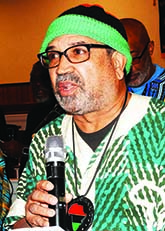
Long Live the Spirit of Ida Wells-Barnett

By Makheru Bradley

When Mississippi seceded from the United States in January 1861 it declared: “Our position is thoroughly identified with the institution of slavery–the greatest material interest of the world.” Ida Bell Wells was born in the northern Mississippi town of Holly Springs on July 16, 1862, during Chattel Slavery and the Civil War. Ida was the oldest daughter of James and Lizzie Wells.
Abraham Lincoln’s Emancipation Proclamation brought freedom to the enslaved Afrikans of Mississippi, if they were able to escape to a contraband camp. Otherwise, they waited for their areas to be liberated by the Union Army, and for Chattel Slavery to be finally outlawed by the 13th Amendment.
During the Reconstruction-era that followed the Civil War, Ida’s parents became active in the Republican Party. James Wells helped start Shaw University (now Rust College), a school for the newly freed Afrikans. Ida began her schooling at Shaw.
The Yellow Fever Epidemic of 1878 forced Ida to drop out of Shaw at the age of 16. Both of her parents and one of her siblings died during the outbreak leaving Wells to care for her other siblings. To handle her new responsibilities, Ida convinced a school administrator that she was 18, and landed a job as a teacher.
Fighting segregation with teeth and pen
The Wells family moved to Memphis in 1882. While riding a train to her teaching job in Woodstock, TN, Ida was told that she had to move out of the segregated women’s car. She gives this account of the incident in her autobiography: “I refused, saying that the forward car [closest to the locomotive] was a smoker, and as I was in the ladies’ car, I proposed to stay. . . [The conductor] tried to drag me out of the seat, but the moment he caught hold of my arm I fastened my teeth in the back of his hand. I had braced my feet against the seat in front and was holding to the back, and as he had already been badly bitten he didn’t try it again by himself. He went forward and got the baggage man and another man to help him and of course they succeeded in dragging me out.” She could have easily been lynched for her self-defense.
Ida Wells sued the railroad company in 1884 for violating equal accommodation statutes, and won. The railroad company was ordered to pay her $500 in damages. However, the Tennessee Supreme Court overturned the verdict, her $500 reward was cancelled and she was ordered to pay court fines.
The train incident launched Ida Wells’ career as an activist and journalist. While continuing her job as a school teacher, Ida began writing articles for Black-owned newspapers under the pen name “Iola.” She attacked every aspect of the apartheid conditions people of Afrikan descent faced in the South. By age 25, Ida was the co-owner and editor of the Free Speech and Headlight, a local black newspaper. In 1891, the Memphis School Board fired Ida from her teaching job because of her articles criticizing the conditions of the city’s segregated schools.
“The Lynching at the Curve”
Three of Ida’s friends, Thomas Moss, Calvin McDowell, and William Stewart started the Peoples Grocery Store in 1889, which drew customers away from a white-owned store in the neighborhood. The owner of the white store attempted to put Peoples Grocery out of business, which included several clashes with Ida’s friends. When their store was attacked in March 1892, they fought back, wounding two white men. This led to their arrests. In the early morning hours of March 9, 1892, 75 men wearing masks took Moss, McDowell, and Stewart from their cells at the Shelby County Jail and lynched them.
“The Lynching at the Curve” ignited Ida Wells’ anti-lynching crusade, which would gain her international fame, numerous threats on her life, and the loss of her newspaper business by white terrorists.
Ida Wells advocates self-defense and exposes the economics of lynching
“The lesson this (The Lynching at the Curve) teaches and which every Afro-American should ponder well, is that a Winchester rifle should have a place of honor in every black home, and it should be used for that protection which the law refuses to give. When the white man who is always the aggressor knows he runs as great a risk of biting the dust every time his Afro-American victim does, he will have greater respect for Afro-American life. The more the Afro-American yields and cringes and begs, the more he has to do so, the more he is insulted, outraged and lynched.” – Ida Wells-Barnett (Southern Horrors: Lynch Law in All Its Phases)
After her friends were lynched, Ida “armed herself with a pistol and spent months traveling alone in the south, researching more than 700 lynchings from the previous decade. Wells visited places where people had been hanged, shot, beaten, burned alive, drowned or mutilated. She examined photos of victims hanging from trees as mobs looked on, pored over local newspaper accounts, took sworn statements from eyewitnesses and, on occasion, even hired private investigators.”
Ida Wells published her findings in newspapers and pamphlets such as “The Red Record,” concluding that more Black men were lynched to maintain white economic and political dominance than for rape.
Marriage, children, and continued activism
Forced out of Memphis, Ida Wells moved to Chicago, where she met and married civil rights attorney and journalist Ferdinand Barnett. The couple had four children. Ida balanced her family life with activism, continuing her anti-lynching crusade with speaking tours that included Great Britain. She formed the National Association of Colored Women in 1896 to fight for civil rights and voting rights for women. In 1898, Wells led a protest at the White House, calling for President William McKinley to outlaw lynching.
Ida Wells-Barnett attended a conference in Niagara Falls in 1909 that led to the founding of the National Association for the Advancement of Colored People, although her name was excluded from the original list of NAACP founders. In her autobiography, Wells stated that W.E.B. Du Bois deliberately excluded her from the list. Within a few years Wells-Barnett would leave the NAACP because she said they lacked action-based initiatives.
Wells-Barnett organized the Negro Fellowship League to provide lodging, employment assistance and social activities when she discovered that the YMCA excluded Black men. That led to the reform of the YMCA's discriminatory practices. In 1913, the efforts of Wells-Barnett and her Alpha Suffrage Club contributed to the passage of the Illinois Equal Suffrage Act.
Late in her career Wells-Barnett focused on the urban problems Black people faced in Chicago, which included opening the first kindergarten in her community. Ida succumbed to kidney disease on March 25, 1931.
From the iconic life of Ida Bell Wells-Barnett, there are numerous lessons to learn, there is a courageous and determined spirit to absorb, and there are models of work ethic and organization to emulate, which we as Afrikan people desperately need in 2020.
For more from the author, follow his blog Makheru Speaks.

